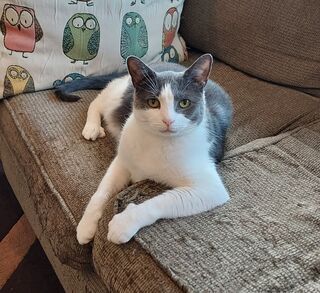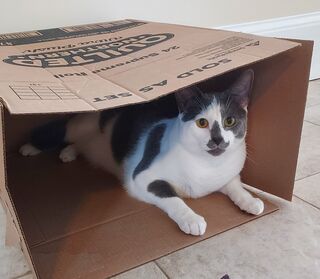Attachment
Do Cats Get What You're Trying to Tell Them?
New research on feline sociocognition and bonding.
Posted October 27, 2022 Reviewed by Lybi Ma
Key points
- Adult humans change their tone of voice when addressing pet cats, much like they do when speaking to dogs and children.
- Cats can discriminate speech addressed to them in this tone from speech addressed to adult humans—but only from their owner.
- Cats did not react differently to cat-directed speech and adult human-directed speech when it was uttered by a stranger.
- These findings add to the growing scientific evidence that cats may form strong attachment bonds with their owners.

Most people talk to their pets. And when they do, they use a particular kind of tone that is similar to the one used when talking to young children. Unlike speech directed towards other adults, speech directed towards pets and kids usually consists of shorter utterances, more repetitions, elevated pitch, and hyperarticulated sounds.
Research suggests that dogs pay more attention when addressed in this way. But little is known about how cats perceive and respond to speech directed towards them.
Speaking “Cat”
As a cat behaviorist, Charlotte de Mouzon helped people better understand and communicate with their pet cats. However, she grew frustrated that there were so few scientific studies in this area. That led her to pursue a Ph.D. at Université Paris Nanterre. She and her colleagues recently published two papers from this project.
In the first study, de Mouzon and colleagues compared speech from men and women directed to cats and speech directed to adult humans. They confirmed that people adapt the way they talk when addressing cats, similar to the way they adapt their speech to address dogs and small children.
The next question was how cats perceive and react to this “cat-directed speech.”
“It had been shown that dogs will react more to this kind of speech,” says de Mouzon. “Previous research had also shown that cats react to their owner’s voice. We combined these questions to ask if cats would react differently to the voice of their owner when it was directed at them versus directed at another adult human.”

To investigate, de Mouzon and colleagues evaluated how 16 adult, indoor cats reacted to pre-recorded voices from both their owner and a stranger when saying phrases in cat-directed and human adult-directed tones. The researchers recorded and rated cat behaviors in response to the playbacks, including resting, ear moving, pupil dilation, and tail moving.
“Interestingly, the cats did react to cat-directed speech when it was from their owner, but they did not show a great reaction to cat-directed speech when it was uttered by a stranger,” says de Mouzon. “This surprised us because dogs have been shown to react to anyone who talks to them in dog-directed speech.”
Cat Communication
de Mouzon says these results suggest a few hypotheses, which are not mutually exclusive. One hypothesis is that since these were indoor cats, it is possible that they were not used to interacting with different humans other than their owners. Unlike dogs, these cats may not generalize cat-directed speech. The researchers suggest that further studies of outdoor cats or other cats with more opportunities to interact with people outside their homes could shed light on this difference between cats and dogs.
A second hypothesis from these findings is the possibility that cats learn that when we talk this way, we are addressing them and it catches their attention. de Mouzon says that learning is important for cat-human communication. Previous studies have shown that adult cats do not meow at one another, but cats learn to vocalize this way to address their humans. In fact, cats that meow the most are usually those that are spoken to the most, especially in their early lives. The results from this study highlight the importance of positive, personal interactions with humans for indoor pet cats.
Finally, although these experiments did not directly address it, the findings reinforce other recent studies regarding the ability of cats to form strong bonds with their humans. Cats, often stereotyped as aloof and independent, are in fact very capable of creating attachment bonds with humans, says de Mouzon—and our behavior towards them can foster these bonds.

“Some humans may be embarrassed by talking to their cats like babies,” she says. “Our results could reassure them that it’s OK because other people do it, too, and it helps to reinforce a good relationship with your cat. They understand when you talk to them like that, and they might be keener on coming to you.”
Feline Friends
An understanding of cats’ sociocognitive abilities, including communication, is essential for improving the quality of our relationships with these animals, as well as pet cat welfare.
de Mouzon emphasizes that there is more to cat communication than vocalizations. She’s also interested in exploring visual cues, like the tail-up display that signals friendliness, as well as tactile communication.
Overall, the researchers say that their work further supports the growing scientific evidence that cats are sensitive and communicative animals. de Mouzon hopes these findings help us understand our pet cats a little better.
“Cat communication can be subtle, and humans are sometimes not very attentive,” she says. “I think cats are better at understanding humans than humans are at understanding cats.”
Facebook image: VH-studio/Shutterstock
LinkedIn image: Hananeko_Studio/Shutterstock
References
de Mouzon, C., Gonthier, M. & Leboucher, G. Discrimination of cat-directed speech from human-directed speech in a population of indoor companion cats (Felis catus). Anim Cogn (2022). Doi: 10.1007/s1007-022-01674-w.
de Mouzon C, Gilbert C, Di-Stasi R, Leboucher G. How's my kitty? Acoustic parameters of cat-directed speech in human-cat interactions. Behav Processes. 2022 Oct 1;203:104755. doi: 10.1016/j.beproc.2022.104755.




